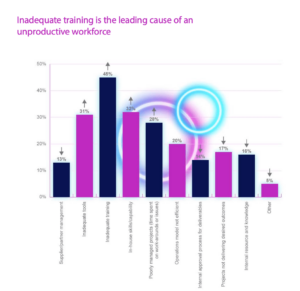3 steps to align project and strategy

With organisations planning significant project and programmes, and envisioning requiring outside third-party help, perhaps the most significant finding in our Productivity Puzzle whitepaper is the recognition that inadequate training is the leading cause of an unproductive workforce – yet none of the significant projects and programmes planned over the coming year are designed to fill this skills gap.
This then asks the question, is there a disconnect on a strategic level between the requirements of an organisation and the project and programme delivery functions? We know large organisations struggle with sharing information, knowledge and cross-team capabilities. Is the disconnect so vast that this is having a direct effect on the decision making of an organisation?
Are organisations struggling to enhance the productivity of their workforce due to a lack of alignment between project and programme delivery and the strategic requirements of the organisations? Perhaps a little simplistic for such a challenging puzzle, but the data certainly would suggest this is case.

As more and more organisations are becoming project-driven, it is important to have a framework in place to ensure alignment between project delivery and strategy. In other words, strategic alignment can help you make sure you allocate your resources correctly and help accelerate your business’ growth.
In this blog, we’ve rounded up the key steps you can take to align your next projects with your overall business objectives:
1. Review every project
Before you begin reviewing every project, it’s essential you have a deep understanding of your organisation’s long-term strategy and goals. Once you know where your company is and where it’s heading to, you should take the time to review all the projects against your business objectives and ensure they are realistic and consistent with your overall strategy.
To align strategy with your projects more effectively, it’s important to set realistic expectations and realise that it’s okay to stop working on any projects which are misaligned with your vision, or which don’t represent a priority for your company anymore. The PMO team can really come into their own here – aligning business goals and objectives and turning them into achievable projects with expected outcomes.
2. Build a roadmap
Creating a roadmap will help you determine each project’s strategic importance and help you prioritise your expected resource requirements and where any potential gaps or capacity issues may come into play. In other words, that’s when resource augmentation planning comes into its own here. To build an effective roadmap, you need to be able to identify the business purpose of each of your projects from the start and focus on the tangible results and metrics that your projects can generate.
It is also important to adopt a proactive manner and be prepared to make any changes as the project advances to ensure it stays relevant and is going to be successful against the goals it was green lit against. Ensure you have project assurance for each of these – how will you adapt and pivot to unexpected changes or unforeseen challenges? How will you track and measure your project’s progress?
3. Keep your priorities straight
Setting priorities can be a difficult task, but it enables your company to get more value from its strategic vision and planning. To define your priorities, you should set clear guidelines for revaluating your projects and openly communicate with your team and the key stakeholders to ensure your project delivery remains aligned with your long-term strategy. It’s also important to ensure you have the right skills, capabilities and people delivering your project.
Here at RPS, we utilise our unique blend of people, process and technology. We work with our partners to manage focused procurement services that really deliver return on investment. Drawing on our expertise in managing high level tenders and e-procurement systems, we understand that the procurement process is an essential element of every project puzzle.
By streamlining and helping you to implement best practice we can work in harmony with your team to ensure your projects are delivered in budget and on time.
To request a copy of the whitepaper or to find out more about how we can help you align your project delivery with your business strategy, please get in touch with our team here.
Contact us
to explore how our tailored solutions can drive your transformation journey.
Get in touch


